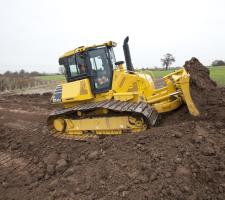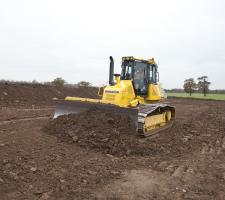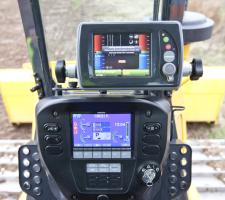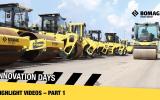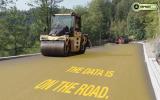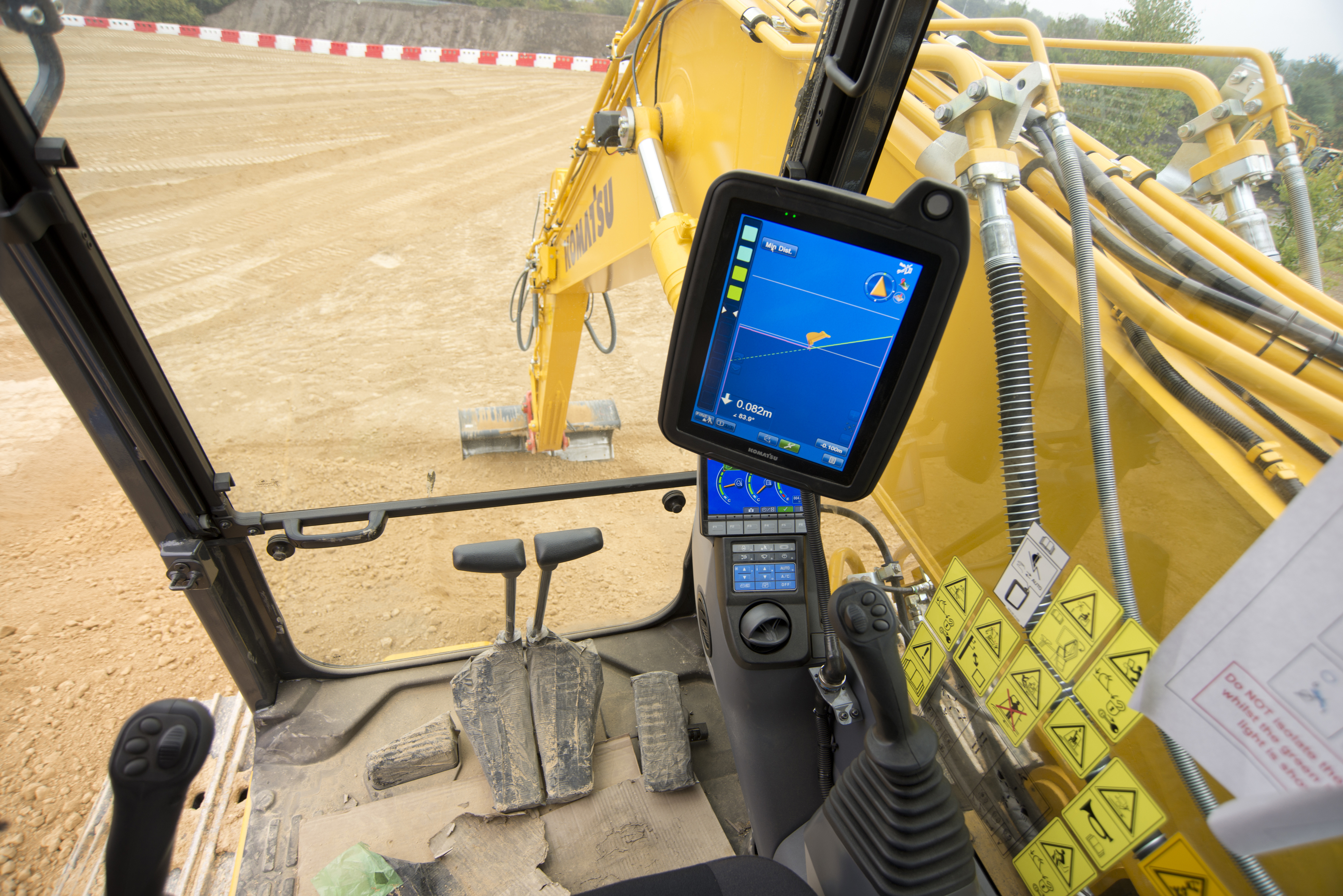
Electronic control of engines, transmissions and hydraulic systems, primarily to reduce exhaust emissions and boost productivity, is also providing manufacturers with an opportunity to incorporate increasingly complex machine control into their equipment. This in turn has the potential to make the machinery more productive, further cutting fuel consumption as part of a virtuous operational circle.
Integrated machine control is set to become increasingly popular, as the benefits of a factory-built set-up become clear to contractors and rental companies, and the necessary electronics more commonplace in machine control systems. Machine guidance technology, from the likes of
That data has been used to provide in-cab graphic representation of the material to be moved and the contours to be created, allowing operators to work accurately and rapidly without constantly referring to marking timbers set out by engineers. In many cases it also prevents over-digging, reducing time spent reworking the same area.
Machine guidance is an accepted method of communicating with multiple machines on site, reducing the need for engineers to constantly check grades and depths. Indeed machine guidance electronics and hydraulic control systems can be built-in to many machines at the factory, ready for on-site installation of GNSS antennas.
Integral machine control however, takes this a step further. Rather than guiding the operator’s hand, to move dozer blades and bucket edges to create the desired grade, machine control actually takes over the machine’s hydraulic system, leaving the operator free to manoeuvre the dozer or excavator.
The dozers have an inertial measurement unit (IMU) built into the bottom of the main frame, basically a pitch and yaw sensor, to record the machine’s orientation and operating angle. A single Global Navigation Satellite System (GNSS) receiver is positioned inside a protective steel dome on the roof of the cab. This is far safer than using two antennas mounted on the blade itself, as there is no need for operators to climb onto the machine to fit the antenna on a daily basis and less chance of damaging the antennas on a daily basis.
The big advance however has come with Komatsu’s stroke-sensing hydraulic cylinders, which use a roller sensor in the cylinder cap to register accurately the ram extension.
By bringing together the exact position of the machine and the position of each hydraulic ram, the system can automatically tell exactly where the dozer blade is in relation to the machine. As the dozer travels forwards, the system constantly computes corrections and sends them to the machine’s hydraulic controls, to position the blade’s elevation and cross-slope angle. The operator simply drives the machine back and forwards, leaving the IMC to work the blade.
Where many plug-and-play guidance systems are only really of use for final fine grade work, leaving the operator to initially strip larger amounts of material, the IMC dozer can rough cut or fine grade, greatly reducing the time taken to reach the desired final contour and material height. Komatsu claims that the IMC dozer can be up to 40% more productive than a conventionally controlled machine, virtually eliminating the need for marking out and stakes on site. With the PC210LCi-10, Komatsu has transferred the IMC technology, including the stroke-sensing hydraulic rams, to its popular 21tonne excavator. As with the dozers, the excavator is capable of rough digging and fine grading work while under the system’s control.
However, as the excavator has a much wider range of movement, it is not yet possible for the IMC system to fully control all boom and slew functions. Instead IMC takes control of the main lift cylinders.
The machine has two small GNSS antennas that do have to be mounted by the operator before use. However, as they sit on the safety handrails on the upper structure, they are easily and safely reached.
The PC210LCi-10 has a 30cm full colour monitor in the cab that shows the desired grade and finish contour in 3D for the operator. It also allows the operator to set a number of parameters before digging commences. This includes a maximum depth, either for trench work of for a slope grade.
With the bucket just above the ground the operator engages the system and simply pulls in the dipper arm lever. The IMC system calculates the bucket’s position in relation to the dipper arm and raises the main boom to keep the bucket at the desired height, preventing over-digging. This is particularly important in a trench operation where there are services below ground, as the operator can ensure that the machine will not dig down to the pipes or cables hidden beneath.
For batter or slope work, IMC automatically lifts or lowers the boom as the operator pulls in the dipper arm, to create the desired slope angle. The driver simply takes over when the time comes to crowd the bucket and lift away the spoil. This can be achieved with the machine at the top or the bottom of the slope, adding to the system’s versatility.
For a more experienced operator, the IMC control reduces fatigue and will help increase productivity and reduce fuel consumption. The benefits for a less experienced operator are even greater, allowing the driver to rapidly gain the confidence to work to finish grades without over-digging.
“The market today is very open to listening to us about this. Job site management in the future is where customers will make money,” said Komatsu Europe’s deputy general manager Dirk Legrand.
“The margins in road construction have become so small that customers are starting to talk to us concerning machine control.”
Certainly the system is finding interested customers, with Komatsu having sold around 50 of the D61PXi dozers in Europe since the launch last year and more than 500 of the machines working worldwide. Those customers that take up IMC have complete access to the machine through Komatsu’s client support and the Komtrax telematic system, both of which can be integrated to some extent with other proprietary site management systems to deliver daily work tasks to the excavator.
However for those looking to take the system to the next stage, Topcon also offers its own Sitelink 3D Enterprise site management tool. Sitelink 3D provides complete access to machine data, allowing a two-way transfer of information. This can be used to provide engineers on site with as-built data from the machine, reducing the need for final engineer checking of grades on site. The system can be used to report daily volumes and for various task management functions, including quality assurance.
At present Sitelink 3D will only work fully with Topcon IMC-equipped machinery. However the company is cooperating with a number of machine manufacturers, including
Once the system can be applied to a broader range of machines, all connected through the internet, IMC will lead to faster job completion, reduced fuel consumption, increased safety and recordable accuracy. It will allow managers to more accurately monitor progress on site, moving machinesto maintain work when necessary and ensuring maximum productivity across the fleet.
Indeed with SiteLink 3D site managers and engineers can remotely take over the in-cab screen, to solve problems and update the site specification as needed without having to leave the office.
Mr Legrand says that up to 20% of construction costs are due to errors in planning, quantities of materials, poor communications or repair work due to over-digging.
“The future is a linked environment: hardware, software, new ways of operating, new technologies and seamless integration,” he said.
“The market will go drastically in this direction in the coming years.”
Control options
Of course Komatsu is not alone in working with machine guidance and control system manufacturers.
The Cat system has dual GNSS antennas mounted on the cab, rather than on the dozer blade. The firm claims that the dual antenna approach adjusts for steep slope work to provide accurate data.
Integrated joystick buttons enable operators to make quick grade adjustments and are said to reduce manual inputs by up to 80 per cent. Grade Control 3D was first seen on the D8T and D9T dozers as far back as 2011, but will be available for the first time on the D6T by mid-2015.


